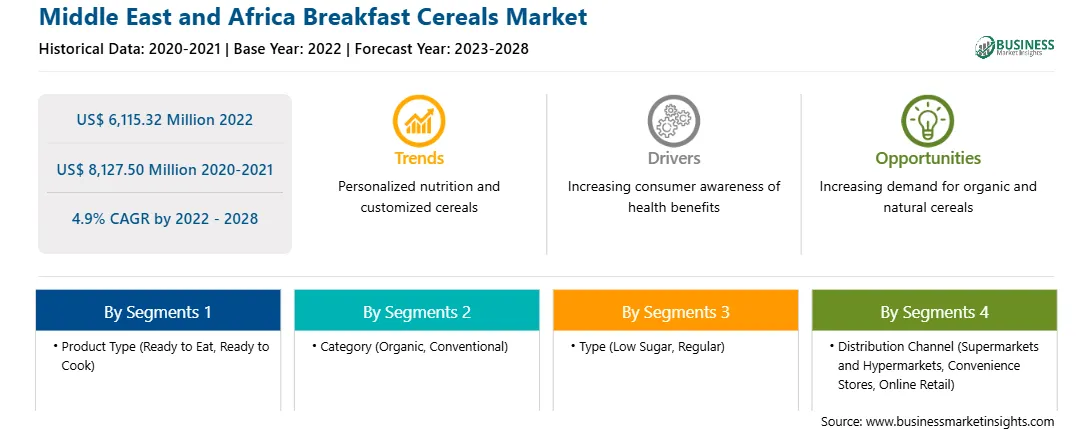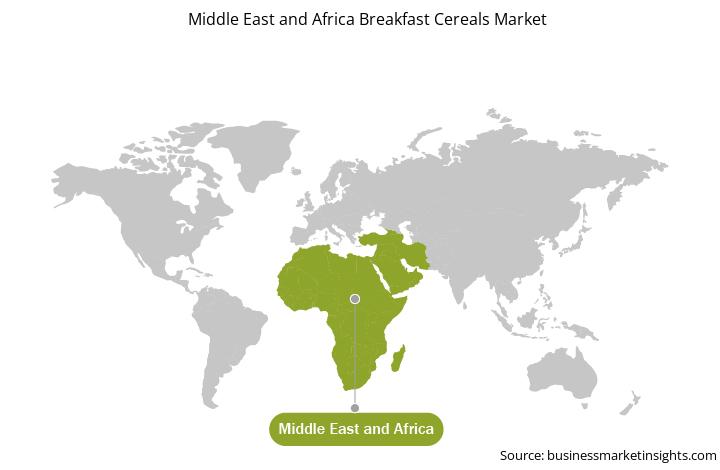Middle East and Africa Breakfast Cereals Market
No. of Pages: 120 | Report Code: BMIRE00025809 | Category: Food and Beverages
No. of Pages: 120 | Report Code: BMIRE00025809 | Category: Food and Beverages
The Middle East and Africa breakfast cereals market is expected to grow from US$ 6,115.32 million in 2022 to US$ 8,127.50 million by 2028; it is estimated to grow at a CAGR of 4.9% from 2022 to 2028.
The market growth in this region is attributed to the rising consumption of low-sugar breakfast cereals and increased knowledge of the health benefits of such breakfast cereals. Cereal manufacturers are developing products with greater nutritional value by adding ingredients such as dried fruits with no added sugar. Ready-to-eat cold cereals containing dried fruits can be chosen as a healthier breakfast option by health-conscious and time-pressed consumers. Moreover, such cereals can be sweetened using sweeteners such as honey, dried fruit, or coconut sugar. Many businesses are concentrating on new ways to combine sugar and sweetening chemicals, often known as flavor modulators, to retain customer taste expectations and product functionality while decreasing sugar consumption. Some products have been improved by lowering their sugar content. Aldi’s Harvest Morn Crunchy Honey Nut Corn Flakes comes with 19% lower sugar content, which was reduced from 34.4 g to 28.0 g per 100 g; moreover, Honey Monster Puffs (previously Sugar Puffs) are offered with a 17% reduction in sugar, from 35.0 g to 29.0 g per 100 g. Further, there have been notable achievements among food manufacturers in reducing salt content. For example, Lidl’s Crown field Corn Flakes come with 60% lower salt content (1.02 g per 100 g), and Simply M&S Cornflakes are offered with 36% low salt content (0.45 g per 100 g).
With new features and technologies, vendors can attract new customers and expand their footprints in emerging markets. This factor is likely to drive the Middle East and Africa Breakfast Cereals market growth at a notable CAGR during the forecast period.
The Middle East and Africa breakfast cereals market is segmented on the basis of product type, category, type, distribution channel, and country. Based on product type, the market is bifurcated into ready to eat and ready to cook. Based on category, the Middle East and Africa breakfast cereals market is divided into organic and conventional. By type, the market is segmented into low sugar and regular. Based on distribution channel, the Middle East and Africa breakfast cereals market is segmented into supermarkets and hypermarkets, convenience stores, online retail, and others. Based on country, the Middle East and Africa Breakfast Cereals market is segmented into South Africa, Saudi Arabia, the UAE, and Rest of the Middle East and Africa.
Middle East and Africa Breakfast Cereals Market —Companies Mentioned
The Kellogg Company ; Bob’s Red Mill Natural Foods; General Mills Inc.; Nestlé SA; The Quaker Oats Company; and Carman's Fine Foods Pty Ltd. are a few major companies operating in the Middle East and Africa Breakfast Cereals market.
Strategic insights for the Middle East and Africa Breakfast Cereals provides data-driven analysis of the industry landscape, including current trends, key players, and regional nuances. These insights offer actionable recommendations, enabling readers to differentiate themselves from competitors by identifying untapped segments or developing unique value propositions. Leveraging data analytics, these insights help industry players anticipate the market shifts, whether investors, manufacturers, or other stakeholders. A future-oriented perspective is essential, helping stakeholders anticipate market shifts and position themselves for long-term success in this dynamic region. Ultimately, effective strategic insights empower readers to make informed decisions that drive profitability and achieve their business objectives within the market.

| Report Attribute | Details |
|---|---|
| Market size in 2022 | US$ 6,115.32 Million |
| Market Size by 2028 | US$ 8,127.50 Million |
| Global CAGR (2022 - 2028) | 4.9% |
| Historical Data | 2020-2021 |
| Forecast period | 2023-2028 |
| Segments Covered |
By Product Type
|
| Regions and Countries Covered | Middle East and Africa
|
| Market leaders and key company profiles |
The geographic scope of the Middle East and Africa Breakfast Cereals refers to the specific areas in which a business operates and competes. Understanding local distinctions, such as diverse consumer preferences (e.g., demand for specific plug types or battery backup durations), varying economic conditions, and regulatory environments, is crucial for tailoring strategies to specific markets. Businesses can expand their reach by identifying underserved areas or adapting their offerings to meet local demands. A clear market focus allows for more effective resource allocation, targeted marketing campaigns, and better positioning against local competitors, ultimately driving growth in those targeted areas.

The Middle East and Africa Breakfast Cereals Market is valued at US$ 6,115.32 Million in 2022, it is projected to reach US$ 8,127.50 Million by 2028.
As per our report Middle East and Africa Breakfast Cereals Market, the market size is valued at US$ 6,115.32 Million in 2022, projecting it to reach US$ 8,127.50 Million by 2028. This translates to a CAGR of approximately 4.9% during the forecast period.
The Middle East and Africa Breakfast Cereals Market report typically cover these key segments-
The historic period, base year, and forecast period can vary slightly depending on the specific market research report. However, for the Middle East and Africa Breakfast Cereals Market report:
The Middle East and Africa Breakfast Cereals Market is populated by several key players, each contributing to its growth and innovation. Some of the major players include:
The Middle East and Africa Breakfast Cereals Market report is valuable for diverse stakeholders, including:
Essentially, anyone involved in or considering involvement in the Middle East and Africa Breakfast Cereals Market value chain can benefit from the information contained in a comprehensive market report.